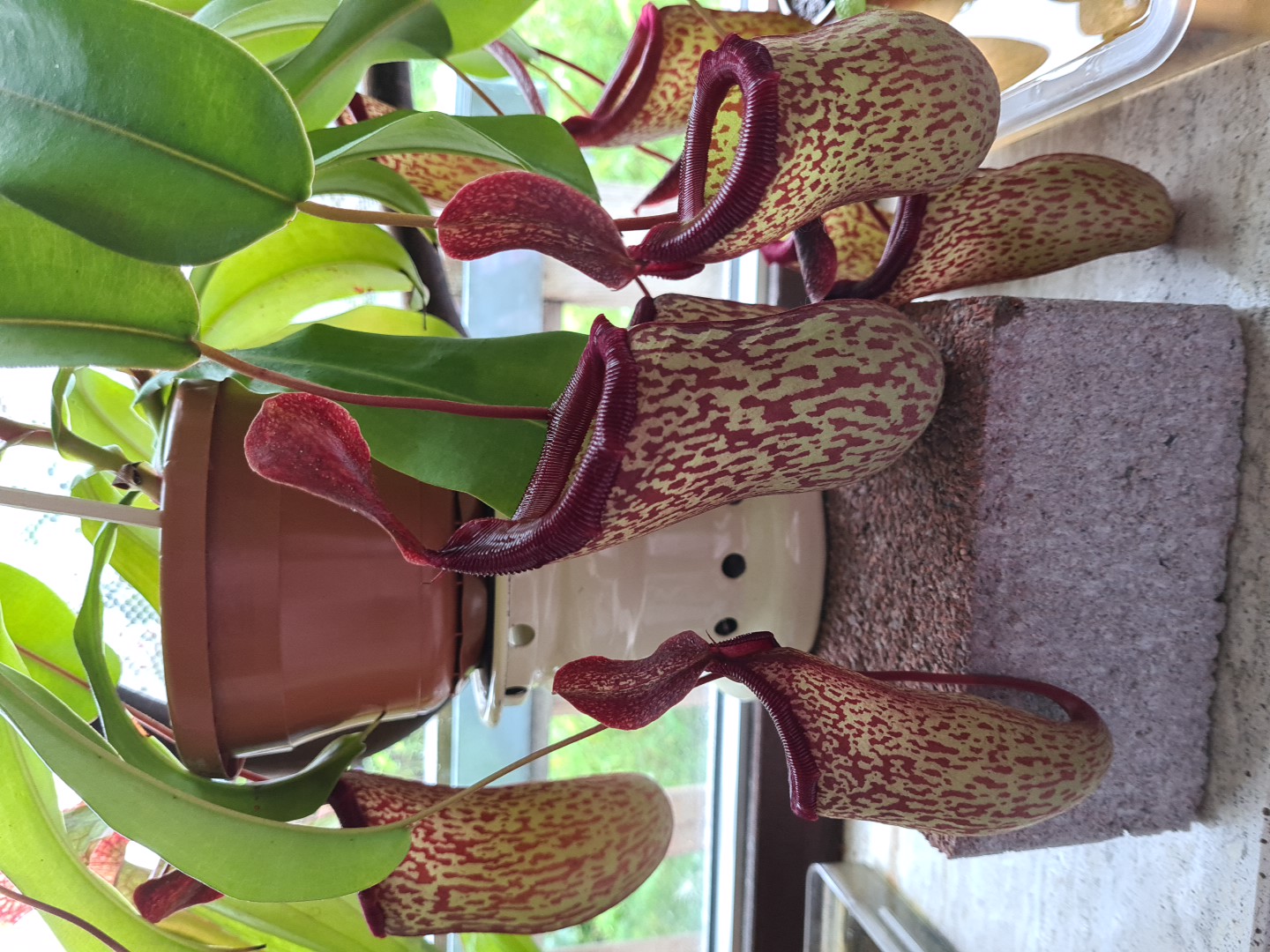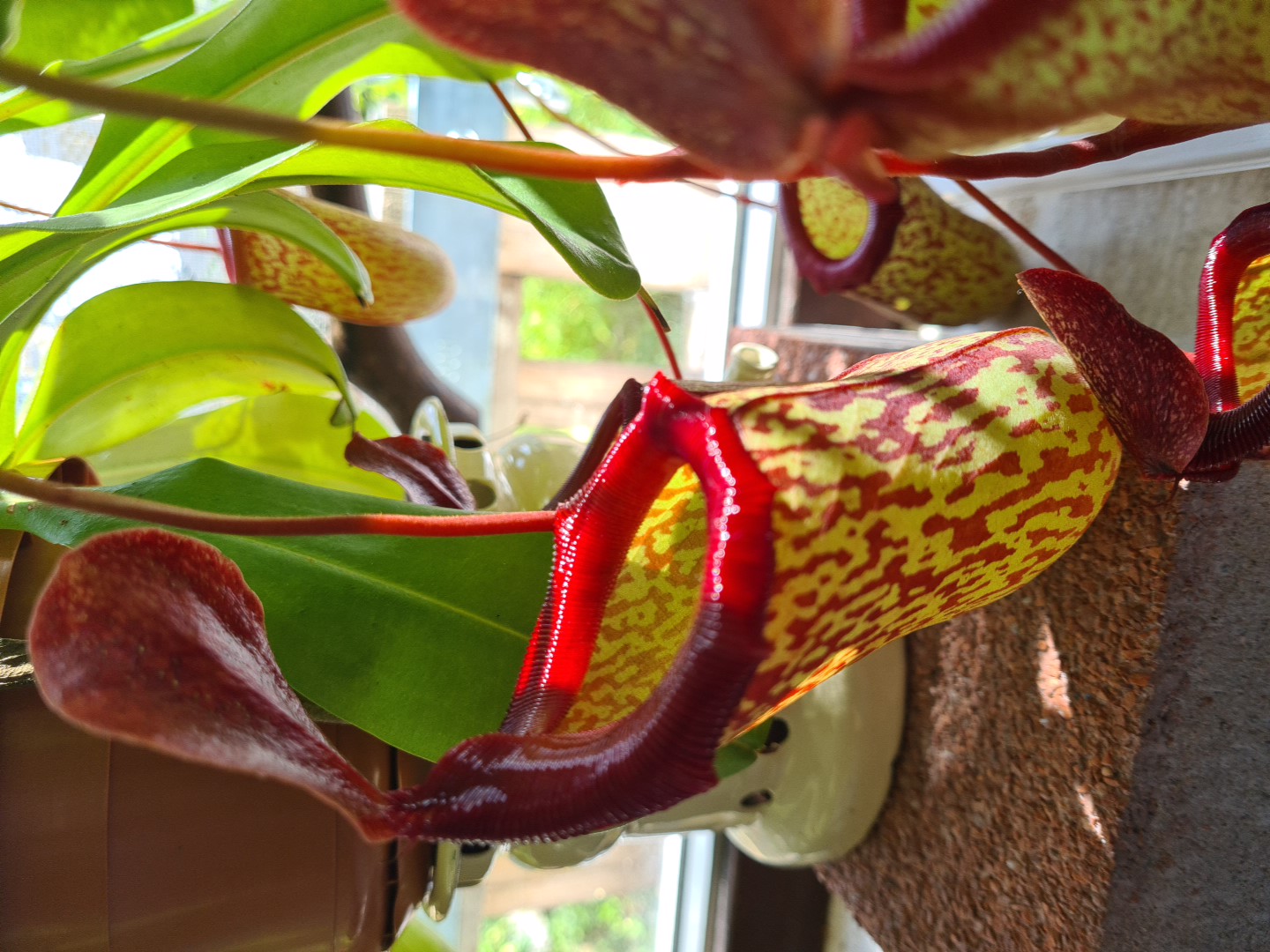

Nepenthes x ‘Sam’
General
Nepenthes x ‘Sam’ is a remarkable hybrid carnivorous plant known for its dramatic, pitcher-shaped traps that capture and digest insects. This cultivar is highly prized among collectors for its unique appearance and adaptable growth habits. Named for its robust vigor and attractive coloration, it brings a touch of the exotic to homes, greenhouses, and terrariums alike.
Physical Characteristics
This hybrid demonstrates vigorous growth with slender, climbing stems that can reach impressive lengths under optimal conditions. Its leaves are long and tapered, often displaying a bright green color with subtle reddish tints near the midrib. The most striking feature is its pitchers: bulbous and often vividly colored with deep reds, maroons, and green mottling. The peristome (the rim of the pitcher) is usually wide and beautifully ridged, enhancing both function and appearance. Pitcher size varies but typically ranges from 10 to 20 cm in mature specimens.
Lifestyle
Nepenthes x ‘Sam’ is an epiphytic or terrestrial vine, meaning it can either climb through trees using tendrils or root in well-draining substrates. Like all Nepenthes, it captures insects by luring them into fluid-filled pitchers where they are digested and the nutrients absorbed, supplementing its diet in otherwise nutrient-poor environments.
Habitat and Protection
This plant thrives in warm, humid environments with abundant but filtered light. It originates from regions where it would typically grow in mossy forests or on the edges of clearings, often at intermediate to high elevations. In cultivation, it is important to mimic these protected, partially shaded conditions to avoid sunburn and dehydration. In its natural setting, it would be sheltered by overhead foliage, which helps maintain humidity and shields from direct midday sun.
Cultivation
Nepenthes x ‘Sam’ adapts well to indoor cultivation, whether grown in a greenhouse, terrarium, or sunny windowsill. It prefers a consistently moist, airy substrate and benefits from high humidity. Given room to climb or trail, it will reward growers with many striking pitchers throughout the year.
Special Features
What sets this hybrid apart is its combination of hardiness and ornamental beauty. It produces pitchers reliably even in less-than-ideal conditions and is more forgiving of minor care mistakes than many other Nepenthes hybrids. The intricate coloration and robust nature make it an excellent candidate for both novice and experienced growers.
Care
Light
Bright, indirect sunlight is ideal. A few hours of early morning or late afternoon sun are beneficial, but avoid harsh midday rays which can burn the leaves and pitchers.
Temperature
Maintains best growth between 20–30°C (68–86°F) during the day and slightly cooler at night. Avoid temperatures below 10°C (50°F).
Water
Use only rainwater, distilled, or reverse osmosis water. Keep the growing medium moist but not waterlogged. Allow excess water to drain freely to prevent root rot.
Soil
A mix of sphagnum moss, perlite, and orchid bark (ratio 2:1:1) provides the ideal airy, moisture-retentive substrate. Avoid nutrient-rich or compact soils.
Nutrition
Fertilizing is generally unnecessary if the plant regularly catches insects. If supplemental feeding is needed, use a greatly diluted orchid fertilizer sparingly, or feed a small insect to a pitcher once a month.
Humidity
High humidity levels (60–80%) are preferred. In drier environments, consider periodic misting or using a humidifier, especially during dry seasons or when heaters are in use.
Dormancy
This hybrid does not require a winter dormancy period. Continue regular care year-round, though growth may slow slightly in cooler, darker months.
Common Problems
Pitchers fail to develop or dry up
Cause: Insufficient humidity or inconsistent watering.
Solution: Increase ambient humidity and ensure the substrate remains evenly moist but not soggy.
Leaves develop brown or black spots
Cause: Sudden temperature drops or fungal infection due to poor air circulation.
Solution: Avoid cold drafts, ensure temperatures remain above 10°C, and provide gentle air movement.
Stunted growth
Cause: Too little light or overcrowded roots.
Solution: Move to a brighter location with filtered sunlight, and repot if the rootball is compacted.
